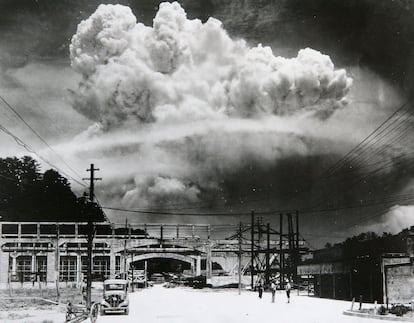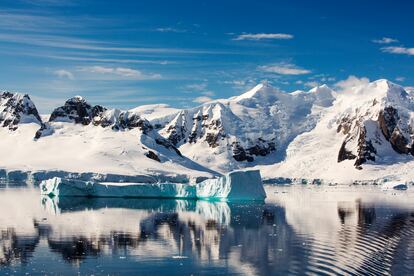Searching for the site that best represents the impact of humans on the planet
Scientists have begun the final phase of choosing the place that bears the most obvious signs of the onset of a new geological epoch – the Anthropocene

On Thursday, November 17, 2022, a select group of geologists, climatologists and paleontologists began the final process of choosing the place on the planet that best represents human-made changes to the Earth. For the next month, they will analyze the nine sites that have the best records of the impact of our actions. The main indicator of that impact is the presence of radioactive material from nuclear tests. But they will also consider the clear, continuous and countable year-by-year footprint left in the sediment of other anthropogenic creations, including particles from burning gasoline, microplastics, technofossils, CO₂, etc. The scientists should have a candidate for a fixed date for the commencement of the Anthropocene – a new geological epoch marking the beginning of significant human impact on the planet – within a month.
Although time goes by constantly, humans break it down into seconds, days, years, decades, millennia.... The geological time scale, which refers to the Earth’s history, is so large that other terms are used: chron, age, epoch, period, era and eon. Eons and eras are the largest temporal units; they span hundreds of millions or billions of years. In general, the separation between each of the major phases is punctuated by a cataclysm, such as the meteorite that wiped out the dinosaurs, marking the end of the Cretaceous period and the beginning of the Paleogene. Shorter timespans are usually marked by more cyclical events, such as glaciation/deglaciation ages or changes in the planet’s magnetic polarity. The Earth is currently in the Holocene, an epoch that began around 11,000 years ago with the end of the last great Ice Age. This group of scientists, who form the Anthropocene Working Group (AWG), is discussing whether the Holocene has ended and humans have begun their own epoch, the Anthropocene, and where that change is most apparent.
University of the Basque Country paleontologist Alejandro Cearreta, an expert on the human footprint and environmental change, is one of the 23 members of the AWG. “All divisions of geologic time have their [own] stratotype, a place where changes are best represented,” he says. The group has been seeking and receiving proposals for stratotypes – places that would definitively mark the beginning of the Anthropocene – for years. Man-made sites, such as the Fresh Kills landfill in the United States, have reached the semifinal selection phase. Opened in 1948, the site served as New York’s garbage dump for over half a century. Nearly 30,000 tons of refuse arrived each day until it was closed in 2002, following the disposal of the rubble of the Twin Towers that had collapsed in a terrorist attack the previous year. The Fresh Kills landfill measures 70 meters in height and covers an area of about eight million square meters; it contains 150 million tons of garbage, which could be the largest human creation ever made. But the landfill did not meet all the requirements to be considered a stratotype and was rejected.

“Searching for a stratotype is complicated,” says Cearreta. To qualify, it must indicate a first change, which is an indication of one of the markers that the scientists have selected. The primary marker is the presence of plutonium-239, the material used in the bomb dropped on Nagasaki, which has also fueled most nuclear tests and powers today’s atomic-loaded missiles. Plutonium-239 and other radioisotopes, such as americium-241 and cesium-137, which are all man-made, are present in soils, peat bogs, lake and sea beds, as well as trapped in ice columns and tree rings. “Plutonium-239 is the primary marker [because] it is artificial, its presence is global and we can follow it year by year,” the Basque scientist explains.
The nine sites (called Global Boundary Stratotype Sections and Points and referred to by the acronym GSSP) that have reached the final round of the selection process have recorded the presence of plutonium-239 since the 1950s. As reported in an article recently published in the scientific journal Science, the options include two marine sediments, one in the Baltic Sea and the other in Japan’s Beppu Bay. Both consist of layers of carbon-rich clays and silt and have captured several of the Anthropocene’s markers, such as spherical carbonaceous particles that can only come from soot released by fossil fuels, microplastics or pesticides. Two reefs, one in the Gulf of Mexico and the other in Australia, are also in the running. Coral reefs can capture geochemical changes from year to year and over the course of centuries. Three other candidates are aquatic as well, but they are located at the bottom of three lakes; the first is in Canada, the second is in China, and the third is in the United States; the last is the reservoir of a US dam built in the late 19th century. Ice cores, one extracted from Antarctica and the other taken from a peat bog in Poland, round out the list of candidates.
Geologist Colin Waters, an honorary professor of geography at the University of Leicester (UK), is also a member of the AWG and the co-author of the recently published paper in Science. Waters explains that the ideal GSSP, which is a boundary between an epoch or period, should be “the best possible record of relevant marker events, such as plutonium fallout.” In addition, the GSSP “must not have discontinuities in the accumulation of strata, and the rate of their accumulation must generate sufficient thickness to be able to distinguish among units of time,” he says in an email. The site must not be altered by the actions of biological organisms or human activities, and it must allow for year-to-year dating. Finally, Waters adds, the candidate site “must have been intensively studied, be accessible for future research and be protected against deterioration.”
Cearreta, Waters and other AWG members have 30 days to select the three finalists. If a site wins 60% of the vote, then it will be the AWG proposal to the International Union of Geological Sciences (IUGS; the organization to which the working group belongs) for marking the beginning of the Anthropocene. If not, the members will continue voting until they choose one of the three. The final decision could come in March at the IUGS summit in Berlin.
The votes are secret and confidential. In addition to selecting the site with the clearest record of the Anthropocene, voters must also determine whether the changes that are occurring are large enough to merit replacing the Holocene. “We have to vote on the scale,” Cearreta says. The Holocene is an epoch, and recently its subdivisions (age or chron) were named (Groenlandian, Norgripian, and Megalayian). “[The AWG] could decide that it’s a subdivision of the Holocene [epoch]…but the scale of the changes that we humans are making to the planet is unprecedented. We have seen other extinctions and geochemical changes, but the speed, quantity and intensity of the current changes are unparalleled,” Cearreta adds.
Waters notes in his email that the Anthropocene will not be classified as a new period (we are now in the Quaternary), much less a new era (the current one is the Cenozoic). Such a change would require a cataclysm, such as the extinction of the human race. But by the time that happens, Cearreta concludes, “it would no longer make sense to call it the Anthropocene, and there would not be anyone around to name it.”
Sign up for our weekly newsletter to get more English-language news coverage from EL PAÍS USA Edition
Tu suscripción se está usando en otro dispositivo
¿Quieres añadir otro usuario a tu suscripción?
Si continúas leyendo en este dispositivo, no se podrá leer en el otro.
FlechaTu suscripción se está usando en otro dispositivo y solo puedes acceder a EL PAÍS desde un dispositivo a la vez.
Si quieres compartir tu cuenta, cambia tu suscripción a la modalidad Premium, así podrás añadir otro usuario. Cada uno accederá con su propia cuenta de email, lo que os permitirá personalizar vuestra experiencia en EL PAÍS.
¿Tienes una suscripción de empresa? Accede aquí para contratar más cuentas.
En el caso de no saber quién está usando tu cuenta, te recomendamos cambiar tu contraseña aquí.
Si decides continuar compartiendo tu cuenta, este mensaje se mostrará en tu dispositivo y en el de la otra persona que está usando tu cuenta de forma indefinida, afectando a tu experiencia de lectura. Puedes consultar aquí los términos y condiciones de la suscripción digital.
More information
Últimas noticias
Most viewed
- Reinhard Genzel, Nobel laureate in physics: ‘One-minute videos will never give you the truth’
- Oona Chaplin: ‘I told James Cameron that I was living in a treehouse and starting a permaculture project with a friend’
- Pablo Escobar’s hippos: A serious environmental problem, 40 years on
- Why we lost the habit of sleeping in two segments and how that changed our sense of time
- Charles Dubouloz, mountaineering star, retires at 36 with a farewell tour inspired by Walter Bonatti











































